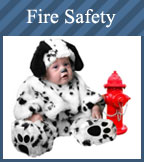Our Fire Safety Prevention & Use of Portable Fire Extinguishers Online Course & Certification is where you will learn the basics of fire safety and prevention for the home & workplace, including what to do in case a fire occurs, how to prevent fires, and how best to avoid situations that may cause fire. It is also geared toward parents and families who wish to become more fire-conscious and prevent fires in the home setting. Consider: more Americans suffer more fatalities each year from home fires than in all natural disasters combined; moreover children under five are twice as likely to succumb to a home fire as compared to the rest of the population.
Our online course is essential for itinerant therapists and teachers – especially in the EI facility - who have young children entrusted to their care. Our fire extinguisher e-training workshop and certification is also appropriate for parents, and caregivers who wish to learn, using easy descriptions and ample illustrations how to safely use a fire extinguisher and prevent fires. Our course complies with OSHA 29 CFR 1910.39 & 1910.157 and will provide the structure for your company's Fire Prevention Program. Moreover, our fire prevention and fire extinguisher certification course complies, with NYS Early Intervention Regulatory Health and Safety Law: Facility Standard 2: 2.2 "All providers delivering services in the facility have a working knowledge of the use of fire extinguishers.” Similar regulations and laws exist in other States of the Union.
Free templates include sample templates for: emergency action plans, company fire prevention plan, potential sources for ignition, potential fire hazards, potential materials hazards, hazardous materials list, fire prevention quickstart list, flammable & combustible materials checklist, generals fire prevention checklist, exits checklist, company hazard survey, company fire extinguisher review form, fire emergency action plan, training wallet card, training record sheet. Course expires after 2 years. Sign up now for this valuable course now!
Course intent: To provide early intervention therapists with an understanding on fire safety & prevention, how to operate a fire extinguisher, and what to do should a fire occur.
Relevance to early intervention: Early intervention providers in the facility based EI setting must, in accordance with local fire law, participate in regular fire drills. However, little if any training is offered with respect to the use of fire extinguishers, and what to do if confronted with fire. This primer provides a comprehensive and clear explanation for all these relevant topics.
Outcomes:
Provider will be able to: Describe proper use of fire extinguishers in the EI facility, day care, or pre-school setting
Provider will be able to: Identify which type of fire extinguisher is applicable in accordance with the type of fire
Provider will be able to: Identify means to egress a facility in a manner that avoids fire, as well as air filled smoke
Provider will be able to: Identify the most common ways that home & workplace fires occur, and how to prevent them
Speech: Level: Various Subject Code: 7060 Patient/Client Safety and Prevention of Medical Errors Area: Related
AOTA Classification Codes:
Category 3: Professional Issues
Legal, Legislative, Regulatory & Reimbursement Issues
Federal & State regulatory Statutes [as related to legal obligation& Good Samaritan laws]
Licensure & Practice Issues [as related to legal obligation &
Good Samaritan Laws]
Contemporary Issues and Trends
Ethics
Professional Development and Continuing Competence
Target level: all levels, all practice areas; introductory
Target Audience: OT, COTA, PT, PTA, Special Instruction, Social Work
Agenda:
- Introduction
- What appliance starts the most fires?
- Fire in the home
- Cigarette fire facts
- Common fire hazards
- Fires in the workplace
- Standpipe and alarm systems
- Electrical fires
- Safety precautions
- Fire extinguishers - Classifications of fire and fire extinguishers
- When to use fire extinguishers
- How to use correctly
- What if a person is on fire?
- Fire Prevention
- Keep your family safe
- Evacuation tips
- If you become trapped
- The work environment
- Emergency action plan






